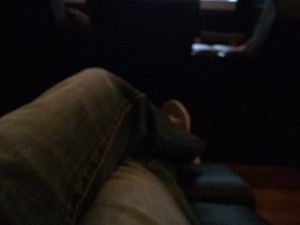Tweet [1]
Pardon the darkness of this photo. I took it on the spur of the moment with my cell phone while sitting on Friday evening in a movie theater in Fairfax. (Although the movie – “Inside Out [2]” – hadn’t yet started, I didn’t wish to be rude and obnoxious by using the flash. So this photo was taken without any flash.)
If you look closely, you’ll see that this is a photo of my legs and feet as I recline in a gigantic theater seat.
 [3]I took this photo to capture an image of something that was unavailable to any middle-class American back in the era that many pundits proclaim to have been the economic golden age for America’s middle-class: the mid-1970s. Gerald Ford in the White House and Howard Hughes in his mansion almost surely could watch movies while sitting in seats equipped with buttons that, when pressed, adjusted the angle and recline of the body to the precise position preferred by the seat’s occupant. But such seats were not available in theaters frequented by ordinary Americans. Yet today, while still not the norm, such cushy, comfy, oversized, reclining seats are becoming more common.
[3]I took this photo to capture an image of something that was unavailable to any middle-class American back in the era that many pundits proclaim to have been the economic golden age for America’s middle-class: the mid-1970s. Gerald Ford in the White House and Howard Hughes in his mansion almost surely could watch movies while sitting in seats equipped with buttons that, when pressed, adjusted the angle and recline of the body to the precise position preferred by the seat’s occupant. But such seats were not available in theaters frequented by ordinary Americans. Yet today, while still not the norm, such cushy, comfy, oversized, reclining seats are becoming more common.
The audio for the movie was projected in Surround Sound – which, while available during the disco decade, was back then of far inferior quality to the Surround Sound that is typical today.
I paid $13.50 for my ticket to this movie, which in 1975 dollars would be about $3.05 [4]. (Also, I opted to pay an extra $1.50 for the convenience of purchasing my ticket on-line and having it delivered to my iPhone via a text message. So there was no waiting in line at the theater to buy my ticket.) The average price of a movie ticket in 1975 (in 1975 dollars) was $2.05 [5].
So, because $3.05 is about 50 percent higher than $2.05, it appears as if the real cost to me of going to that movie on Friday night was higher than it was 40 years ago. But that appearance clearly is distorted. The bundle of what I bought yesterday (movie with great Surround Sound, a roomy and reclining seat with its own dedicated cup holder) was far better than was the bundle of what the typical American moviegoer in 1975 bought.
Was the superiority of my bundle (to the bundle in 1975) worth at least $4.42 (the value, in 2015 dollars, of the one-dollar difference, in 1975 dollars, between the price of my movie ticket on Friday and the average price of a movie ticket in 1975)? For me, personally, the answer is unambiguously ‘yes.’ That seat and the superior sound of the movie were certainly worth that expense. But my own assessment is not one that can be generalized to other people.
If $13.50 were today the average price of a movie ticket, then the inflation-adjusted price of a movie ticket is today higher – again, by about $4.42 in 2015 dollars – than it was 40 years ago. But because the bundle of consumption items purchased in the form of a movie ticket is today better than it was 40 years ago, it’s practically impossible (if not theoretically so, using hedonic pricing [6]) to draw welfare conclusions simply from the fact that the inflation-adjusted price of my movie ticket in 2015 is higher than was the average price of a movie ticket that I bought in 1975.
As people become wealthier, additions to the quantity of goods and services become less and less important to them as do (1) improvements to the quality of goods and services, and (2) expansions in the options of goods and services from which to choose. Because national-income-accounting statistics are far better at measuring changes in quantities than in qualities,* national-income-accounting statistics are, I believe, destined to measure economic performance less and less reliably as ordinary people become more prosperous.
….
The price of the movie ticket that I bought on Friday is higher than is the average movie-ticket price today. Today’s average movie-ticket price is $8.12 – which, when converted into 1975 dollars is $1.84. So the true real price of movie tickets in the U.S. has fallen, over the past 40 years, by about 10 percent. (WARNING: This conclusion is built on the assumption that the CPI is the most-appropriate means of adjusting for inflation – an assumption that, while widely accepted and acted upon, can be seriously questioned.)
…..
…..
* The greater difficulty of statistically measuring changes in qualities than in doing so for changes in quantities is due in part to (1) the inherently greater difficulty of quantifying changes in quality (compared to quantifying changes in quantity), and, relatedly, (2) the greater difficulty of observing changes in quality (compared to observing changes in quantity). For example, slightly softer cushioning in the armrest of a theater seat might be noticeable – and pleasantly so – to the theater patron who sits in that seat for two hours, but not noticeable to some statistician who is intent on discovering and accounting for all quality changes in consumer products.